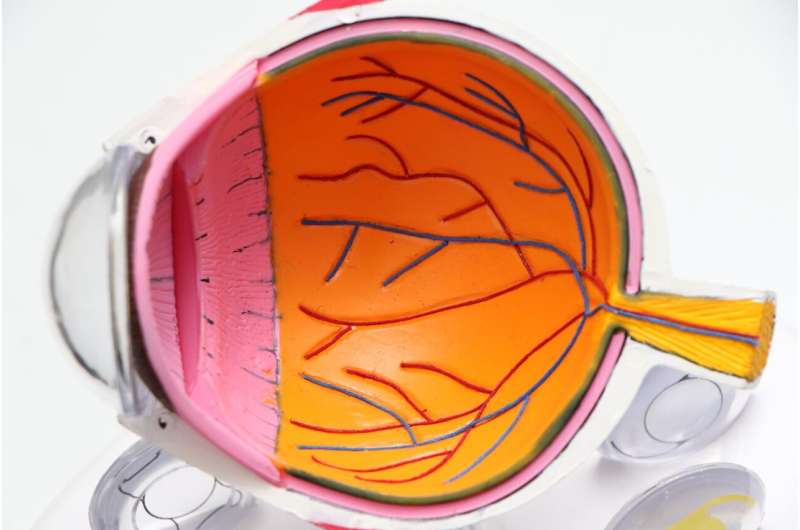This article has been reviewed according to Science X's editorial process and policies. Editors have highlighted the following attributes while ensuring the content's credibility:
fact-checked
peer-reviewed publication
trusted source
proofread
Australian study calculates cost of going blind as $5.2 million per person

Researchers have for the first time calculated the lifetime cost of living with an inherited eye disease in Australia as $5.2 million per person. Distressingly, a significant portion of the cost associated with the progressive loss of vision is absorbed by the individuals affected and their families, with over one-third of these costs being due to loss of individual and family income over their lifetime.
The findings have been published in the Medical Journal of Australia, thanks to the work of teams from Macquarie University's Center for Economic Impacts of Genomic Medicine, Sydney Children's Hospitals Network (SCHN), Children's Medical Research Institute (CMRI), Save Sight Institute (SSI), and the University of Sydney.
Inherited diseases of the retina (the light-sensitive cells at the back of the eye) include blinding eye conditions such as Stargardt disease, retinitis pigmentosa, Leber congenital amaurosis and many more. Some appear in childhood, and some in adults who all suffer from progressive deterioration of eyesight, typically leading to blindness.
While health care and societal costs are routinely modeled for most diseases, comprehensive Australian data for inherited retinal diseases have not been available until now.
Professor Robyn Jamieson is Head of the Eye Genetics Research Unit at CMRI and SSI and is a Professor of Genomic Medicine at the University of Sydney. Her team has collaborated with Professor Deborah Schofield, Director, Macquarie University's Center for Economic Impacts of Genomic Medicine and her group, to address the lack of information about lifetime costs of inherited retinal diseases.
Professor Jamieson also led the team that delivered the first successful gene therapy for a genetic eye disease in Australia in 2020. She says progress is being slowed by the need for more investment in research.
"In 20 years, I have seen such incredible progress. Research in the field of genetic eye diseases offers immense possibilities—to maximize the ability to deliver definitive genetic diagnoses and develop many kinds of cutting-edge therapies to stop, and even reverse, vision loss and restore sight. However, lack of research funding has been a major challenge," Professor Jamieson said. "This study shows the enormous societal cost to Australia from inherited retinal diseases and the critical need for research investment to tackle these debilitating conditions."
Professor Schofield said this study was long overdue.
"Some diseases are highly visible such as those with large hospital costs for example, but patients with a form of genetic eye disease experience very substantial costs borne by patients and their families as well as large costs outside the health system which often go unnoticed," Professor Schofield said.
"This is why the microsimulation model deployed in this study is so useful for gathering often-hidden individual and societal costs."
Professor John Grigg, Professor of Ophthalmology, SSI, University of Sydney, a clinician with specialist expertise in inherited retinal diseases who was involved in the study, said these diseases can have devastating impact.
"We aren't just talking about children who are born with a genetic eye disease, sometimes these diseases occur in adults who then are unable to continue their successful careers," Professor Grigg said. "I know health care workers and other professionals, who are doing extraordinary work—and suddenly they are affected by one of these diseases and cannot continue in their jobs. They can feel as though their contribution to society has been lost."
Professor Jamieson said, "People with inherited eye diseases who are losing their vision often take it as their own personal responsibility, trying to build a resilient mindset, feeling they really don't want to rock the boat. There are many patients and families without a genetic diagnosis and most without a therapy. We really need the research funding to work on diagnoses and novel therapies."
Junko Katsuda has watched her 11-year-old son lose his vision due to Stargardt disease and said his condition should be treated with the same urgency as other genetic conditions.
"While they may not be immediately life-threatening, the impact on an individual's quality of life, independence, and future opportunities is immense. It is crucial that these conditions receive equitable support, research funding, and access to innovative therapies," Ms. Katsuda said.
"The investments made today will not only alleviate the financial strain on families and the healthcare system but also empower individuals with genetic eye diseases to lead fulfilling lives, contribute back to society, and reduce their dependence on social support systems."
The authors reported a lifetime cost of $5.2m per patient, of which 87% was attributable to societal costs and 13% to health care costs. In the adult cohort, only 62% were working. Notably, only 41% had National Disability Insurance Scheme support.
More information: Deborah Schofield et al, The health care and societal costs of inherited retinal diseases in Australia: a microsimulation modelling study, Medical Journal of Australia (2023). DOI: 10.5694/mja2.51997





















